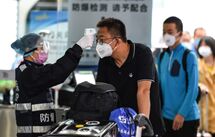坐飞机如何防范新型冠状病毒?专家来支招
|
假期结束要坐飞机返程,如何在飞机上防范新型冠状病毒的感染?健康专家说,最好的办法就是使用消毒洗手液多洗手。 Worried about air travel amid the current epidemic? Wash your hands. 疫情期间乘坐飞机出行感到担忧?勤洗手吧。 Health experts say the best protections you can undertake are the same prescribed for avoiding flu, common cold and other viruses: washing hands frequently and using hand sanitizers. 健康专家说,你能采取的最佳防护措施与预防流感、普通感冒和其他病毒的方法相同,就是使用消毒洗手液勤洗手。 sanitizer ['sænɪtaɪzə]:n.消毒杀菌剂
Though much of the focus of the novel coronavirus outside of China has been on travelers, riding on airplanes doesn’t expose you to any greater risk than other situations where you are in close contact with possibly sick people: subways, movie theaters, lines at the grocery store. 尽管在中国之外,对这种新型冠状病毒的关注大多聚焦于旅行者,但与其他和可能患病的人有密切接触的情况相比(如地铁、电影院、杂货店排队),乘坐飞机并没有让你面临更大的风险。 But flying does put you in close contact with people, and studies have shown that travelers have a higher risk for getting sick. One study pegged the increased risk of catching the common cold at 20% if you’re on a plane. 但乘飞机确实会让你与人发生密切接触,而且研究表明,旅行者患病的风险更高。一项研究认为,乘飞机时患上普通感冒的风险会增加20%。 Research in 2009 tracing H1N1 flu transmission on a flight found that 2% of passengers had the disease during the flight and 5% came down with the disease within a week after landing. Coach passengers were at a 3.6% increased risk of contracting H1N1 if they sat within two rows of someone who had symptoms in-flight. That increased risk for post-flight disease doubled to 7.7% for passengers seated within a two-seat hot zone in any direction. 2009年进行的追踪甲型H1N1流感在航班上传播的研究结果发现,2%的乘客在飞行期间感染了这种流感,5%的人在飞机降落后一周内发病。经济舱乘客在飞行中如果坐在有流感症状乘客周边的两排座位,感染风险增加3.6%。任何方向的两个座位之内都是热点区域,该区域的乘客飞行后患病风险增至7.7%。 Another study modeling risk between economy class and first class concluded with the obvious: the chances of exposure are lessened if there are fewer people around you. If a flight is full, there would be less chance of getting infected in first class compared with coach. But the odds could be flipped if first class is full and economy class isn’t. 另一项研究模拟了经济舱和头等舱的风险,结论显而易见:如果周围的人较少,接触病毒的几率就会降低。如果航班客满,头等舱感染的几率小于经济舱。但如果头等舱客满而经济舱没有,那么感染的几率就可能正好相反。 Coronavirus is a respiratory virus that is thought to be transmitted through tiny droplets excreted by coughing and sneezing. Research on other viruses has shown that on an airplane, you are at risk if you are within two or three rows of an infected person—basically the distance a droplet might travel. 冠状病毒是一种呼吸道病毒,据认为是通过咳嗽和打喷嚏排出的飞沫传播。对其他病毒的研究结果显示,在飞机上,如果你坐在距离感染者两到三排内,就有危险了——这基本上是飞沫可以传播的距离。 respiratory [rəˈspɪrətri; ˈrespərətri]:adj.呼吸的
Air on airplanes is generally isolated to specific zones. In addition, most aircraft flying today pass recirculated air through a series of filters 20 to 30 times an hour. The filters used, called High-Efficiency Particulate Air, or HEPA, filters, are hospital-operating-room grade and capable of removing 99.9% of particulate such as bacteria, fungi, larger viruses and virus clumps, according to the Centers for Disease Control and Prevention. 飞机上各个区域的空气一般相互隔离。此外,当今的大多数飞机通过一系列过滤器每小时循环空气20到30次。据美国疾病控制和预防中心说,飞机使用的过滤器名为“高效微粒空气过滤器”(HEPA),达到医院手术室级别,能够清除99.9%的微粒,比如细菌、真菌、较大的病毒和病毒团块。 “The cabin air environment is not conducive to the spread of most infectious diseases,” the CDC says in a briefing on air travel. 美国疾病控制和预防中心在关于航空旅行的简报中说:“机舱空气环境不利于大多数传染病的传播。” The World Health Organization says its general recommendations for travelers apply to coronavirus: 世界卫生组织给旅行者提出了适用于冠状病毒的一般预防建议: * Frequently clean your hands by using alcohol-based hand rub or soap and water. 经常使用含酒精的洗手液或肥皂洗手。 * When coughing and sneezing, cover your mouth and nose with flexed elbow or tissue, throw that tissue away immediately and wash hands. 咳嗽和打喷嚏时,弯曲手肘或用纸巾捂住口鼻,完毕后立即扔掉纸巾并洗手。 * Avoid close contact with anyone who has a fever and cough. 避免与发烧和咳嗽的人密切接触。 * If you have a fever, cough and difficulty breathing, seek medical care early and share previous travel history with your health-care provider. 如果你有发烧、咳嗽和呼吸困难等症状,尽早就医,并告知医疗服务提供者之前的旅行经历。 |









